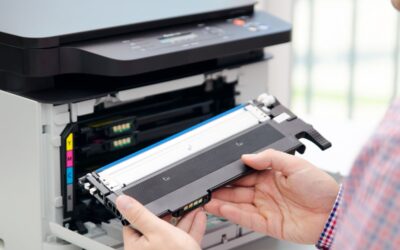What does PPM mean, and how is it measured?
PPM stands for pages per minute and measures printer speed. It is calculated by dividing the total number of pages printed by the time it takes to print them. PPM compares different printer speeds and determines the most suitable task.
What categorizes a printer as high-speed?
Several factors contribute to high ppm printers:
Print engine:
The print engine is the core component of a printer that determines its speed. High ppm printers often have advanced print engines that are designed to process and print pages quickly.
Print technology:
Different print technologies have varying speeds. Laser printers are usually faster than inkjet printers. They use a laser beam to move toner onto the page rapidly. However, there are also high-speed inkjet printers available on the market.
Paper handling:
High ppm printers usually have efficient paper handling mechanisms to minimize paper jams and maximize continuous printing. These include large paper trays, high-capacity input and output trays, and automated duplex printing. This means it can print on both sides of the page.
Processing power:
The printer’s internal processing power affects its printing speed. High ppm printers often have powerful processors and sufficient memory to efficiently handle complex print jobs and large data files.
Connection:
A high ppm printer may offer fast connection options, such as USB 3.0, Ethernet, or wireless. This ensures that data is sent quickly from the computer to the printer, preventing potential issues.
Print resolution:
The print resolution refers to the level of detail and clarity in the printed output. High ppm printers can maintain a high print resolution while printing fast, ensuring both speed and quality.
High-speed printers can vary depending on the context and the specific type of printer technology. Here are some examples of printers known for their high printing speeds in their respective categories:
- Laser printers: Laser printers are known for their fast-printing speeds. Laser printers are widely used in business and office settings. They come with varying speeds, ranging from 30 to over 100 pages per minute.
Such speeds are considered high speed. These printers can quickly print large volumes of text and graphics precisely.
- Production printers are specialized for high-volume printing. They are used in commercial printing shops, print-for-pay businesses, and other professional printing settings.
Printers can achieve breakneck printing speeds. This can range from 100 to several hundred pages per minute (ppm). The exact number varies depending on the model and configuration.
- Inkjet printers: Advancements in inkjet technology have led to the creation of high-speed inkjet printers. This is an improvement, as inkjet printers had traditionally been slower than laser printers. These printers use advanced print head arrays and high-performance inks to achieve fast printing speeds.
- Multifunction printers (MFPs): Multifunction printers combine printing, scanning, copying, and sometimes faxing capabilities into a single device. High-speed MFPs can print at speeds of 30 ppm or higher. These printers are commonly used in busy office environments where efficiency and productivity are critical.
Black and white versus color: which is faster?
Compare black and white (monochrome) printers to color printers when looking for high ppm capabilities. There are a few key factors to consider:
- Speed disparity: Monochrome laser printers generally have higher ppm ratings than color printers. Color printing requires combining several colors, usually cyan, magenta, yellow, and black. This creates a large variety of hues, which takes more time.
- Application and usage: The choice between black and white or color printing depends on the printer’s intended use. A high ppm black and white printer is the best choice for printing text documents, forms, and black and white graphics. It is also more cost-effective than other types of printers.
A high ppm color printer is more suitable for printing marketing materials, presentations, and other items that require vivid colors. If you often print such things, this type of printer is the ideal choice. - Print quality: Another factor to consider is print quality. Black and white printers can typically achieve higher resolution and sharper text output since they only use black toner or ink. Color printers can produce high-quality prints, but the text may be slightly lower due to the color mixing involved.
- Cost Considerations: Color printing generally incurs higher costs due to the need for multiple color cartridges or toners. Color printers often require individual color cartridges, and if one color runs out, it needs to be replaced separately, which can be expensive. Black and white printing, on the other hand, involves only a single cartridge or toner, resulting in lower ongoing costs.
Printers can be categorized into different ppm (pages per minute) categories based on their speed. The specific types may vary slightly depending on the source or industry, but here are some standard classifications:

Personal/Home Printers:
- Low ppm: Up to 10 ppm
- Moderate ppm: 10 to 30 ppm
Small Office/Workgroup Printers:
- Moderate ppm: 10 to 20 ppm
- High ppm: 20 to 40 ppm
- Very High ppm: 40 to 60 ppm
Business/Enterprise Printers:
- High ppm: 20 to 40 ppm
- Very High ppm: 40 to 60 ppm
- Ultra-High ppm: 60+ ppm
Production Printers:
- High ppm: 60 to 100 ppm
- Very High ppm: 100 to 200 ppm
- Ultra-High ppm: 200+ ppm
It’s important to note that these categories are approximate and can vary based on the specific printer model, technology, and the manufacturer’s specifications.
Does your organization need a high ppm printer?
It’s important to note that the definition of high speed can vary based on industry standards, advancements in printer technology, and individual requirements. When considering a printer, it’s best to assess your specific needs, such as the volume of printing, the type of documents you need to print, and your budget, to determine what printing speed would be considered high for your situation. Contact BDS to get started with high-speed printing.






